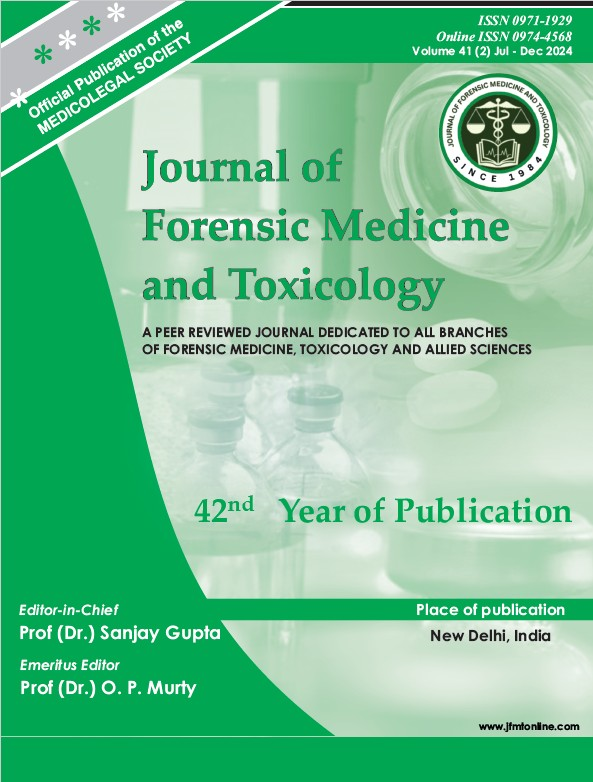EVALUATION OF CARDIAC BIOMARKERS IN THE PERICARDIAL FLUID TO DETECT DEATH DUE TO ISCHAEMIC HEART DISEASE - AN AUTOPSY BASED STUDY
DOI:
https://doi.org/10.48165/jfmt.2024.41.2.35Keywords:
Sudden Death, Cardiovascular system, ischemic heart disease, Bio markers, Creatine phosphokinaseAbstract
Death is not an event; it is a process. 10% of all deaths are sudden and unexpected deaths. 45% to 50% of sudden deaths involve the cardiovascular system. Heart diseases are one of the most common causes of sudden death. The body of the deceased is brought for autopsy in cases of sudden death to ascertain the cause of death. the identification of early myocardial infarcts at autopsy poses a challenge to the autopsy surgeon, since unequivocal gross changes of infarcts do not become evident for the first twenty-four to forty-eight hours following the ischemic injury to myocardium. Clinicians use cardiac biomarkers such as CPK, CPK-MB, Troponin I&T, to screen living patients for acute MI. Hence if these markers could be measured from the pericardial fluid and if found to be high in cases of sudden death due to myocardial ischemia, they could prove a vital clue to establish the cause of death. Pericardial fluid is easy to collect, analyze and gives accurate results even, a long time after death. The aim of this study hence is to detect varying levels of cardiac biomarkers CPK and CPK-MB in the pericardial fluid to confirm myocardial infarction or ischemic heart disease as the cause for sudden death. Pericardial fluid was collected in 50 cases of sudden death and the levels of biomarkers measured. Levels of both markers were elevated. However further studies are required to evaluate the applicability of these markers to detect sudden death cases due to cardiac causes.
Downloads
References
Reddy K S, Murty O P, editor. The essentials of forensic medicine and toxicology. 34th ed. Jaypee Brothers; 2017.
Aggrawal A. Textbook of Forensic Medicine and Toxicology.1st ed. Avichal publishing company; 2014.
Adegboyega PA, Adesokan A, Haque AK, Boor PJ. Sensitivity and specificity of triphenyl tetrazolium chloride in the gross diagnosis of acute myocardial infarcts. Archives of pathology & laboratory medicine. 1997 Oct 1;121(10):1063.
Jaiswal SK, Yadav A, Thakur PS, Tripathi A. Role of TTC in Early Diagnosis of Suspected Acute Myocardial Infarction Autopsy Cases: Our Experience in Central India. Call for Editorial Board Members. 2019 Jul;12(3):185.
Yusuf AA, Weinhandl ED, Peter WL. Comparative effectiveness of calcium acetate and sevelamer on clinical outcomes in elderly hemodialysis patients enrolled in Medicare part D. American journal of kidney diseases. 2014 Jul 1;64(1):95-103.
Madhavan SR, Reddy S, Panuganti PK, Joshi R, Mallidi J, Raju K,et al. Epidemiology of sudden cardiac death in rural South India-insights from the Andhra pradesh rural health initiative. Indian Pacing and Electrophysiology Journal. 2011 Jul;11(4):93.
Mair J. Cardiac troponin I and troponin T: are enzymes still relevant as cardiac markers?. Clinica Chimica Acta. 1997 Jan 3;257(1):99-115.
Expert Group on Biomarkers. Biomarkers in Cardiology Part 2: In Coronary Heart Disease, Valve Disease and Special Situations. Arquivos Brasileiros de Cardiologia. 2015 May;104(5):337-46.
Jaffe AS. New standard for the diagnosis of acute myocardial infarction. Cardiology in Review. 2001 Nov 1;9(6):318-22.
Srivatsa UN, Swaminathan K, Munavarah KS, Amsterdam E, Shantaraman K. Sudden cardiac death in South India: incidence, risk factors and pathology. Indian pacing and electrophysiology journal. 2016 Jul 1;16(4):121-5.
Mehdi HK, Raju KA, Raghuveer C. A Five Year Analysis of Sudden Death Cases at A Tertiary Care Hospital in South India-A Postmortem Study. J Clin DIAGNOSTIC Res. 2018 Mar 1; 12(3):06-9.
Pandian JR, Laishram RS, Kumar LD, Phuritsabam P, Debnath K. Autopsy review of sudden deaths in a tertiary hospital of northeastern India. Journal of Medical Society. 2014 Sep 1;28(3):145-8.
Osuna E, Pérez-Cárceles MD, Vieira DN, Luna A. Distribution of biochemical markers in biologic fluids: application to the postmortem diagnosis of myocardial infarction. The American journal of forensic medicine and pathology. 1998 Jun 1;19(2):123-8.
Luna A, Villanueva E, Castellano MA, Jimenez G. The determination of CK, LDH and its isoenzymes in pericardial fluid and its application to the post-mortem diagnosis of myocardial infarction. Forensic Science International. 1982 Jan 1;19(1):85-91.
Ooi DS, Isotalo PA, Veinot JP. Correlation of antemortem serum creatine kinase, creatine kinase-MB, troponin I, and troponin T with cardiac pathology. Clinical chemistry. 2000 Mar 1;46(3):338-44.
Stewart RV, Zumwalt RE, Hirsch CS, Kaplan L. Postmortem diagnosis of myocardial disease by enzyme analysis of pericardial fluid. American Journal of Clinical Pathology. 1984 Oct 1;82(4):411-7.
Hopster DJ, Milroy CM, Burns J, Roberts NB. Necropsy study of the association between sudden cardiac death, cardiac isoenzymes and contraction band necrosis. Journal of clinical pathology. 1996 May 1;49(5):403-6.




